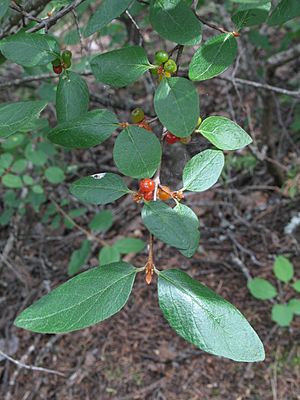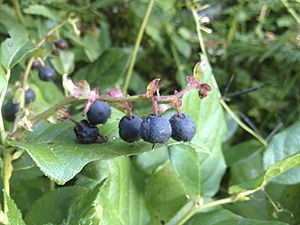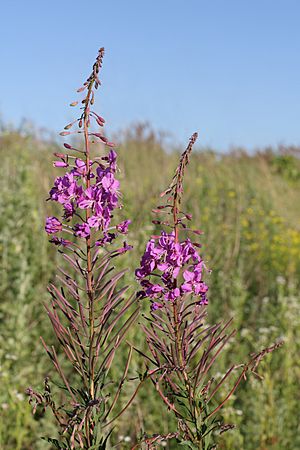Indian ice cream (Canada) facts for kids
| Type | Dessert |
|---|---|
| Place of origin | Canada |
| Region or state | Pacific Northwest |
| Main ingredients | Canada buffaloberry, water; sometimes mild sweeteners |
Indian ice cream, also known as sxusem (pronounced "s-khushem"), is a special Canadian dessert. It's a whipped treat made from a fruit called soapberries (Shepherdia canadensis) and other fruits. Many First Nations people have enjoyed this traditional dessert for a very long time. It's thought that it was first made in the Interior Salish lands of British Columbia. This area was near the Columbia and Fraser rivers and was home to tribes like the Columbia, Lillooet, and Shuswap.
Contents
What Goes Into Indian Ice Cream?
Making Indian ice cream usually involves a few simple things:
- soapberries
- water
- some kind of sweetener
People add sugar as needed. This is because the taste of soapberries can be very different from one bush to another. Some are more bitter and need more sugar to make them sweet.
All About the Soapberry Plant
A soapberry bush is usually a small to medium-sized tree. It can grow up to 30 feet tall, sometimes even 45 feet! It has leaves that grow in a feather-like pattern, clusters of flowers, and a yellowish, see-through fruit. Soapberries belong to the Elaeagnaceae plant family.
You can find these bushes scattered across the United States, often along stream banks, at the edges of forests, or in disturbed areas. They are also found in parts of northern Mexico.
It's important to know that some other plants are also called "soapberry," but they are not the same as the edible Canada buffaloberry. These other plants, from the genus Sapindus, are not meant for eating. The Canada buffaloberry is also known by many other names, including:
- Western soapberry
- Canada buffaloberry
- Foamberry
- Soopolallie
Sweeteners for Sxusem
People have used different things to sweeten Indian ice cream over time.
Sweet Berries
Salal Berries
One of the most common natural sweeteners for Indian ice cream was salal berries (Gaultheria shallon). They were popular because they were always available and always tasted sweet.
Thimbleberries
Thimbleberries are another type of berry that First Nations people gathered a lot. They have a wonderfully sweet taste. People added them to teas, cakes, and, of course, Indian ice cream.
Mild Sweeteners
Fireweed
First Nations people, like the Coast Tsimshian, often used fireweed (Chamerlon angustifolium) as a sweetener. They would use the sweet petals of the fireweed plant. They also used the outer part of the fireweed stem to help whip the soapberries!
Camas Bulb
The Camas bulb comes from an herb that First Nations people used in many ways. After baking or boiling, the bulb tastes like a sweet potato, but even sweeter. It could be crushed and mixed with whipped sxusem to make it sweeter and give it a thicker texture.
Modern Sweeteners
Cane Sugar
When European traders first brought sugar, it changed how coastal First Nations people ate. It was a new and special taste. Sugar was mixed with Indian ice cream, but people said that adding too much could spoil the flavor.
How Sxusem is Whipped
To make Indian ice cream, the berries are put into a large bowl. This bowl must be completely clean and free of any oil or fat. Then, a sweetener is added. The mixture of berries is crushed and beaten very hard, just like whipping cream. This makes the special foam that Indian ice cream is known for.
Some tribes used timbergrass or the bark from Rocky Mountain Maple trees as tools to whip the berries. Other tribes used bunches of inner cedar bark, thimbleberry branches, or salal branches in birch bark bowls. If you whip quickly, it can take about 10 minutes to get the foam just right.
The foam forms because of special ingredients in the soapberries called saponins. These saponins help trap air bubbles, making the mixture light and foamy. If there's any grease or oil in the bowl, it can stop the foam from forming properly.
Nutrition in Indian Ice Cream
A serving of Indian ice cream (about 125mL or 100g) usually has some fat, protein, calcium, and small amounts of iron and vitamins.
Just soapberries themselves don't have much protein or fat. So, for Indian ice cream to have more nutrients, recipes often include other ingredients like milk, eggs, nuts, or dried fruit. These additions can make the dessert even more nutritious.
How People Enjoy Sxusem
The texture of Indian ice cream can be different depending on how much water is added. It can be a thin, frothy drink or a thick, ice cream-like foam.
First Nations people from places like the Pacific Northwest, Oregon, and Flathead regions often add more water to make a frothy drink. In areas like Clallam, Coeur d’Alene, and Alaska, people prefer a thicker, ice cream-like dessert. They use less water, or sometimes no water at all.
One old way to enjoy it was to add snow flavored with smoked mountain goat fat after whipping the berries. Today, people might add fruits like bananas or raspberries after whipping to make the dessert even sweeter.
Eating Too Much Sxusem
Eating a lot of soapberries can sometimes cause an upset stomach, like vomiting or diarrhea. This is because of the saponins in the berries. However, it's very rare for this to happen with the amount of Indian ice cream people usually eat.
Since Indian ice cream is mostly trapped air, eating too much might just make your stomach feel uncomfortable from swallowing too much air. Some people say that blowing bubbles with the ice cream in your mouth can help prevent this feeling.
Harvesting Soapberries
Soapberry plants can be either male or female, but only the female plants grow berries. When soapberries are ready to be picked, they have a few key features:
- Color: They are orange to red and slightly see-through.
- Size: A ripe soapberry is usually about 1/4-inch or less across.
- Texture: If you crush a ripe berry, it will make a soapy foam.
- Taste: Ripe soapberries have a bitter taste.
Soapberries are harvested in dry areas during the summer months, usually in July, August, and September.
People don't pick the berries by hand. Instead, they use a branch to gently knock the ripe berries off the bush onto a blanket spread below. This way, only the berries that are ready are collected.
Saponins: The Foaming Secret
Saponins are the natural chemicals in soapberries that give them their bitter taste and their amazing ability to foam. These compounds are found throughout the plant – in the roots, stems, leaves, flowers, and fruits. They help protect the plant from bacteria, fungus, and insects.
Saponins are special because they can reduce the "surface tension" of water. This means they help air mix with water and stay trapped, creating a stable foam. When you beat soapberries, the saponins allow air to get trapped, turning the liquid into the light, airy Indian ice cream foam. It's similar to how egg whites foam when you beat them!
Other Uses for Soapberries
Besides being a key ingredient in Indian ice cream, soapberries have many other uses. People can crush the berries, soak them in water, and then process the liquid to get saponin extract.
This extract can be used as a natural detergent for laundry, shampoo, or soap. Soapberries can also be used in industries as foaming agents or moistening agents in various hygiene products. In some places, saponins from natural sources like soapberries are even approved to help make foam in certain drinks.
Storing Soapberries
Traditionally, people would dry soapberries in the sun and store them in cedar boxes, with thimbleberry leaves for protection. Today, you can freeze them in well-sealed containers or can them in tin. It was important that the containers used for storing berries were not used for cooking or other purposes, to make sure no grease would touch the berries.





